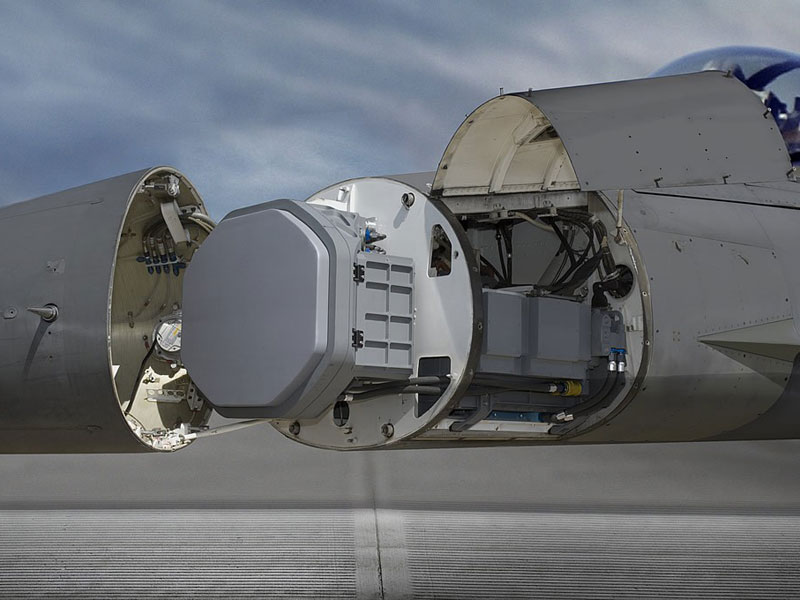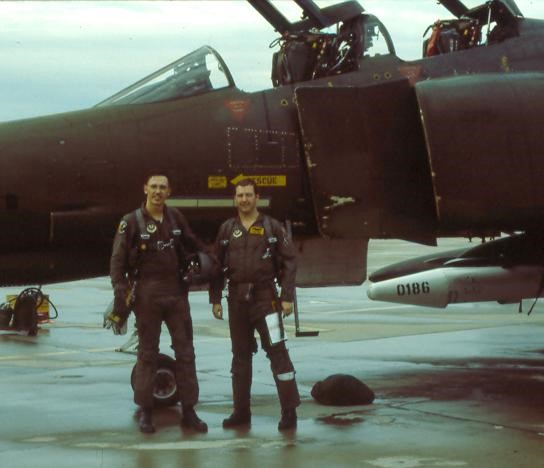By: Warren Gray
Copyright © 2023
“If an F-16’s RCS (radar cross-section) was to be reduced to something
equivalent to that of a (F/A-18E/F) Super Hornet (one meter squared),
for example, radar detection range would be shortened by about 30-45% –
something that could be critical to mission success, or even survival!”
— Jon Lake, for Key Aero, April 1, 2021
The General Dynamics F-16C/D Fighting Falcon has been in production since 1984, and is the most widely used fourth-generation, multi-role, jet fighter in the U.S. Air Force, with a kill-to-loss ratio of 76-to-one (including forty-four kills by Israel alone, in just two days in 1982) in aerial combat, but it’s definitely not a stealth fighter. In order to be competitive and survive in today’s high-technology arena of modern combat, it must be heavily modified to reduce its radar cross-section (RCS) and detectability by enemy radars, both in the air and on the ground.
Even very modern stealth fighters like the F-22A Raptor are not totally invisible to radar and can be detected at closer ranges of about three to six miles, but by the time the enemy sees it on radar, it’s already too late. The F-22 will certainly have fired its missiles well before that time. So, the key objective with a non-stealth fighter like the F-16 is to give them every possible advantage in detecting enemy aircraft first, with longer-range radar, and remaining undetected themselves until it’s too late to stop them.
The U.S. Air Force recognized this requirement very early in the life cycle of the F-16 fighter series, and initiated the “Have Glass” program to reduce the RCS of existing Fighting Falcons as much as possible, from their standard size of 5m² (like a 16.5×16.5-foot sheet of aluminum), the same as a Russian MiG-29 Fulcrum fighter, to the RCS of something more technologically advanced, like the U.S. Navy’s F/A-18E/F Super Hornet, with a radar cross-section of only 1m² (like a 3.3×3.3-foot sheet of aluminum).
Initially, the Have Glass I phase introduced an ultra-thin, vapor-deposited layer of indium-tin-oxide into the F-16’s one-piece, polycarbonate, bubble canopy, giving it a slightly golden tint that reflected radar frequencies, in order to conceal the pilot’s head and the top of his ejection seat from hostile radars.
This was followed in 1986 by Have Glass II, a new phase adding radar-absorbing material (RAM) into the belly-mounted, air-intake ducting, behind the radar antenna, and within 60 percent of the overall airframe. This involved various coatings of FMS-3049 RAM foam material, slightly less than a half-inch thick, containing ferromagnetic particles embedded in a polymer base, which added 220 pounds of extra weight to the aircraft, but when combined with Have Glass I modifications, reduced the F-16’s RCS by 15 percent, not a huge advantage, but worth the effort.
The problem with weight gain in a highly-maneuverable aircraft like the Fighting Falcon is that now you need to increase engine performance and thrust to offset the negative effects of extra weight, which in turn increase fuel consumption, so you eventually end up adding external fuel tanks, which contributes to aerodynamic drag, further reducing fighter performance and maneuverability. It’s a vicious cycle.
Take a closer look at the F-16CM in the photo above. This is an aircraft originally designed to be a lightweight, very maneuverable dogfighter, yet over time, it has gained weight, requiring twin, 370-gallon, external fuel tanks, and the needs of sophisticated, modern warfare have added an AAQ-33 Sniper XR targeting pod under the right side of the air intake, offset by an ASQ-213(V)7 HARM targeting system (HTS) pod for launching AGM-88E radar-killing missile against enemy missile sites, and a bulky, rectangular, ALQ-184(V)9 electronic-jamming pod on the belly-mounted station.
All of this extra fuel and electronic hardware adds a significant amount of weight (nearly 2,000 pounds for the electronics alone) and drag to the F-16, which is no longer considered a true “dogfighter,” but is currently used as a multi-role fighter-bomber instead. Its defensive missile load consists of two AIM-120C-7 Slammer radar-guided missles on the wingtips, and a pair of heat-seeking AIM-9M Super Sidewinders on the outer wing stations. The muzzle opening for the internal, M61A1 Vulcan 20mm Gatling gun (with 511 rounds of ammunition on average) is visible below and behind the cockpit area.
This leaves only enough room for typically four 500-pound bombs on double ejector racks, usually including two GBU-12, -49, or -54C laser-guided weapons (not visible in the photo) on the right side, and two GBU-38 GPS-guided bombs on the left.
The F-16CM’s standard radar is the Westinghouse/Northrop Grumman APG-68(V)9, with a detection range of about 68 miles against larger, fighter-sized, aerial targets, but the Air Force has begun to slowly upgrade all F-16s with the highly-advanced, Northrop Grumman APG-83 SABR (Scalable, Agile-Beam Radar), leveraging fifth-generation, radar technology from the F-35A Lightning II stealth fighter’s APG-81 system.
This active, electronically-scanned array (AESA) radar has about 25-percent greater range and resolution than the previous, mechanically-scanned, APG-68 model, bringing the Fighting Falcons well into the 21st century to extend their service life. The upgraded F-16CM, with the new radar and some minor, structural improvements, is called the Block 70 model in USAF service, or the F-16V Viper as an export model, offered to Bahrain, Greece, India (as the F-21), Indonesia, Morocco, Singapore, and Slovakia, and already flown in large numbers by Taiwan.

APG-83 SABR radar fitted to F-16CM Fighting Falcon jet. Photo credit: Northrop Grumman
The APG-83 SABR radar gives Fighting Falcons greater air combat capability than the most-advanced Russian Su-35S Flanker-E+ fighters in service, retaining our vital, technological edge, and the SABR is so effective that it is also planned to eventually equip all U.S. Air Force B-52H Stratofortress and B-1B Lancer bombers, as well as U.S. Navy and Marine Corps F/A-18C/D Hornet fighters. The APG-83 entered USAF service in January 2020, at Joint Base Andrews, in Maryland.
Have Glass II upgrades were primarily applied to F-16CM “Wild Weasel” fighters, like the one in the photograph above, from Spangdahlem Air Base, Germany, tasked with suppression of enemy air defenses (SEAD) and destruction of enemy air defenses (DEAD, but pronounced “Deed”). Have Glass II applied a special two-tone, low-observable, metallic-sheen paint, using a computer-aided, spray-paint-expelling robot (CASPER) system.
Not much is known about any Have Glass III or IV improvements, so they must have been relatively minor projects, but since approximately 2012, the U.S. Air Force has very slowly introduced brand-new Have Glass V upgrades, consisting primarily of a dark-gray (or “Have Glass Gray”), single-tone scheme of new, radar-absorbing, ferromagnetic paint, in a color (FS36170) basically identical to that of the F-35A Lightning II stealth fighter, possibly to visually confuse enemy pilots, and make the upgraded F-16s look more like highly-advanced F-35s from a distance.
The U.S. Air Force has finally conceded that it cannot acquire stealthy F-35s fast enough, so they’ve now begun a service-life extension program on more than 800 of their approximately 900 F-16s, covering all but the very oldest, Block 25 models that entered service in the early 1980s. Have Glass V and the APG-83 radar are at the heart of that ambitious update program, and the new paint scheme has already been seen at F-16CM bases in Florida, Nevada, South Dakota, Texas, Italy, and Germany, as shown above.
With all Have Glass improvements, the F-16 Fighting Falcon’s radar signature is reduced to just 1.2 square meters, which is roughly 50-percent lower than Have Glass II models, and 76-percent lower than early, unmodified F-16s. It doesn’t turn the F-16 into a full-fledged stealth fighter, but every little bit of survivability helps, and now the Fighting Falcon can see 25-percent farther with its radar, and be 50-percent less detectable than any models preceding the Have Glass V modifications, making it much more efficient and survivable during combat operations.
* * *

Author (on left) with F-4E Phantom II jet fighter in Spain, 1985. (Photo by author)
Warren Gray is a retired, U.S. Air Force intelligence officer with experience in joint special operations and counterterrorism. He served with three fighter squadrons in Europe and the Middle East (two F-4E Phantom II squadrons in Germany, and one F-117A Nighthawk stealth fighter squadron in Saudi Arabia), earned Air Force and Navy parachutist wings, and four college degrees, including a Master of Aeronautical Science degree, and was a distinguished graduate of the Air Force Intelligence Operations Specialist Course, and the USAF Combat Targeting School. He is currently a published author and historian. You may visit his web site at: warrengray54.vistaprintdigital.com

